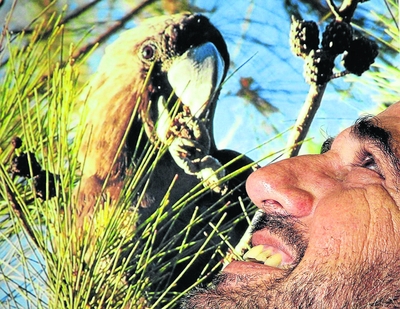 ADRIAN Caneris, managing director of Biodiversity Assessment and Management which won an award for work to preserve the subspicies of the glossy black-cockatoo. Photo by Chris McCormackCLEVELAND Biodiversity Assessment and Management (BAAM) has recently won an award for its outstanding professional service for the establishment, growth and success of the pro-bono Glossy Black Conservancy.
ADRIAN Caneris, managing director of Biodiversity Assessment and Management which won an award for work to preserve the subspicies of the glossy black-cockatoo. Photo by Chris McCormackCLEVELAND Biodiversity Assessment and Management (BAAM) has recently won an award for its outstanding professional service for the establishment, growth and success of the pro-bono Glossy Black Conservancy.
BAAM, an environmental consulting company, was proud to receive the prestigious award, which involved environment industries from across Australia and New Zealand.
Managing director Adrian Caneris said the Glossy Black Conservancy was the first time a single focused conservancy had been able to achieve this kind of support from the government.
"Even koala groups haven't been able to achieve this kind of support," he said.
"It's a credit to everyone who has been involved, the level of partnership that it has with both government and non-government."
Mr Caneris said it had taken some time from its beginnings in 2005, but had many people involved so now "it has almost taken on a life of its own".
"In some way's we have created a monster. There's people out there that are so enthusiastic about this bird, we are collecting way more records, information, far more emails than we ever thought we would," he said.
He said the Glossy Black Conservancy now had records of the three subspecies from outside Townsville to the Snowy River National Park in Victoria and on Kangaroo Island off the South Australian coast.
"We've now got the environment department asking us if a bird is known in a certain area. That's certainly a big credit to the organisation."
Mr Caneris said the Glossy Black-Cockatoos were known for their highly specialised diet, feeding almost exclusively on the seeds of she-oak trees.
"They only eat that one type of food and they also feed it to their young. These guys have one of the most restrictive diets in the bird world ? more restrictive and specialised than a koala," Mr Caneris said.
A lot of their food was grown in disturbed areas where she-oak trees had been planted to revegetate an area.
"So that's another reason why we have wanted to do this as a lot of their food is grown in areas where they're not protected," he said.
"The bay islands are a classic example of that. Old disused cattle farms have since been revegetated with she-oaks and these birds are eating that."
He said a lot of the research had been done on Macleay Island, where they had seen young birds and breeding behaviour.
"Unfortunately we've never actually been able to locate a nest on the island, but they only nest in a hollow limb or a hole in a trunk of a tree," he said.
"They're hard to follow, and you try to follow them on sand tracks but it's really hard."
Mr Caneris said he had a dream of creating a conservancy for flying foxes "but I'm not quite ready to do this just yet".